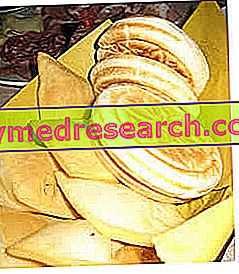Generality
Tigelle or crescentine are a typical food of the Emilia-Romagna region, in particular in the province of Modena. They belong to the category of bread and derivatives, since they are obtained from the formulation of a leavened dough based on wheat flour and water;

Etymology: over the years, by metonymy, the term "tigelle" has replaced the real name of this food, or "crescentine"; the rhetorical mutation of the noun "tigelle" occurred with the propagation of the food itself, originally consumed only near the Modenese hills, but later disclosed throughout the regional plain and in the neighboring territories. For a first analysis there is no concrete reason for which it was necessary to exchange "the contents for the container", but it is not so; on the eastern territory near the Modena area, in the province of Bologna, a food of the same name is consumed but different in composition and cooking procedure: a fried dough called precisely "crescentina". For this reason, everywhere except in Modena, crescentina means a bolognese food based on fried dough, while the term "tigella" refers to the small disks of Modena bread to be cooked in the special terra cotta or griddle tool.
recipe
Contemporary tigelle or crescentine can be produced following different types of recipes, while the culinary process always remains the same. On the other hand, the traditional formula of tigelle or crescentine is clear: white wheat flour (type 00), water, natural yeast, lard, salt and lard. NB . Some use a part of milk instead of water and others use brewer's yeast instead of sourdough (or sourdough); frequent use of sugar.
It is however necessary to specify that, following a global awareness in the health field, the traditional recipe of tigelle or crescentine has undergone some radical changes (even if the supporters of the "crescentina modenese" jealously preserve every detail of their typical food) . The essential change that many companies and artisans have decided to make to the recipe of tigelle is the replacement of the animal fats present in the dough (lard) and those added for cooking (lard) with extra virgin olive oil. By this arrangement it is possible to zero the cholesterol content and drastically reduce that of saturated fatty acids in the finished product, to the benefit of the overall healthiness of the tigelle.
Another clarification concerns the yeast to be used; seen and considered the "age" of tigelle or crescentine, it is conceivable that originally the leavening medium was made of sour dough; today, for convenience and practicality, we obtain tigelle or crescentine also through the use of brewer's yeast, while the chemical one (as well as preservatives) is a yeast used exclusively by industrial producers.
As anticipated, the process of the tigelle or crescentine is always the same:
- Dissolve the sugar and salt in one part of water / milk and the yeast in another
- Make a fountain with flour on a pastry board
- In the center, pour: water / milk with sugar and salt, the liquid with the levito and the oil or lard into small pieces softened.
- Knead vigorously and place in a floured bowl covered with a damp cloth.
- Let rise until doubled in volume.
- Divide the dough into cakes and, one by one, spread them into sheets about 1 / 2cm or 1cm thick; with a cup-dough, separate the discs of diameter there about 10cm.
- Cook the discs in a tigella (or in a metal tigelliera or on the plate or in a pan) slightly greased (with oil or lard), turning them often.
With regard to the ingredients of tigelle or crescentine, we bring a couple of examples:
Recipe 1 - traditional : flour type 00 500g, yeast 25g, water 200g, lard 80g, salt QB; lard to grease.
Recipe 2 - more healthy : type 00 600g flour, 25g brewer's yeast, 150g cow's milk, extra virgin olive oil 30g, QB sugar, QB salt; oil for anointing.
Tigelle - Crescentine Modenesi
X Problems with video playback? Reload from YouTube Go to Video Page Go to Video Recipes Section Watch the video on youtubeA variation of our local tigelle is the Batbout, a really good Moroccan bread cooked in a pan, don't miss the videoricetta
Nutritional properties
First of all, we reiterate that, containing gluten, tigelle are not suitable for the celiac diet. Furthermore, those prepared with milk do not even lend themselves to feeding lactose intolerant subjects.
Tigelle or crescentine are baked goods belonging to the whole of cereals and derivatives, therefore to the III group of foods. They have a very high energy intake (especially from complex carbohydrates) and are not suitable for ordinary food (especially for overweight people). Furthermore, due to the considerable glycemic load, large portions of tigelle are NOT recommended for subjects with type 2 diabetes mellitus. NB . Recipes that use sugar have a greater fraction of simple carbohydrates.
The lipid profile of tigelle or crescentine varies according to the recipe; those that require the use of lard bring significant amounts of cholesterol (not visible in the table below) and saturated fatty acids, which is why they should be avoided in the diet of those suffering from hypercholesterolemia; on the other hand, those based on extra virgin olive oil do not have the same negative implications, even if the high caloric intake imposes, however, an occasional and moderate consumption.
Tigelle or crescentine proteins are scarce and of medium biological value. The amount of dietary fiber is similar to that of ordinary bread, while the amount of water is erroneously high, as the table does not take into account the dehydration that occurs with cooking.
As far as mineral salts are concerned, considerable concentrations are not evident, while with regard to vitamins the amounts of thiamine are always discrete; for tigelle with lard, those of niacin seem to be good, and the amount of retinol equivalent in crescentine with milk is just as satisfactory.
Of course we must also consider the nutritional contribution of a possible filling, which can range from sauces to cured meats, from spreadable cheeses to vegetables, significantly affecting the nutritional contribution of the dish. The combination of tigelle - lean cured meats (bresaola, defatted cured ham, turkey breast) and vegetables (courgettes, peppers, rocket, valerian ...) is certainly preferable to that between tigelle and fatty salami (salami, pancetta, coppa, mortadella), fat or semi-fat cheeses (stracchino, philadelphia, gorgonzola ...), mayonnaise, jam or chocolate.
Nutritional values
 | |||
| Recipe 1 | Recipe 2 | ||
| Edible part | 100.0% | 100.0% | |
| water | 32.8g | 28.1g | |
| Protein | 7.8g | 8.9g | |
| Prevailing amino acids | - | - | |
| Limiting amino acid | - | - | |
| Lipids TOT | 10.4g | 6.2g | |
| Saturated fatty acids | 4.4g | 1.4g | |
| Monounsaturated fatty acids | 4.4g | 4.0g | |
| Polyunsaturated fatty acids | 1.6g | 0.8g | |
| Cholesterol | - | - | |
| TOT Carbohydrates | 50.8g | 59.5g | |
| Starch | 0.0g | 0.0g | |
| Soluble sugars | 1.2mg | - | |
| Dietary fiber | 2.0g | 1.9g | |
| Soluble | - | - | |
| Insoluble | - | - | |
| Power | 315.0kcal | 314.5kcal | |
| Sodium | - | - | |
| Potassium | 112.5mg | 124.6mg | |
| Iron | 0.7mg | 0.6mg | |
| Football | 14.5mg | 36.6mg | |
| Phosphorus | 69.4mg | 75.6mg | |
| Thiamine | 0.10mg | 0.08mg | |
| Riboflavin | 0.10mg | 0.06mg | |
| Niacin | 1.21mg | 0.77mg | |
| Vitamin A | 0.10RAE | 8.75RAE | |
| C vitamin | 0.10mg | 0.20mg | |
| Vitamin E | 0.30mg | 1.21mg | |



